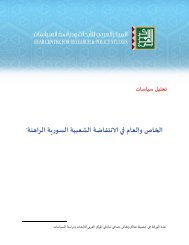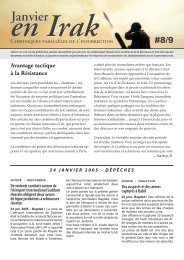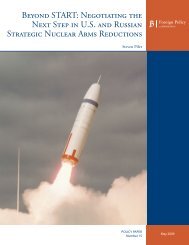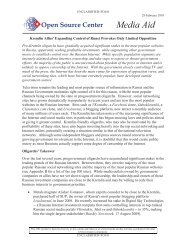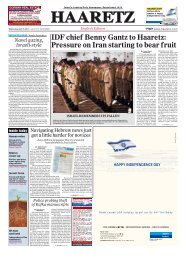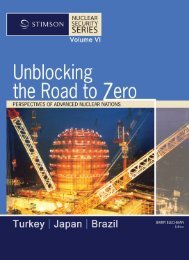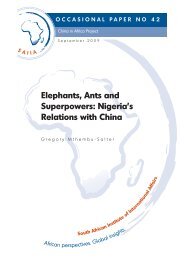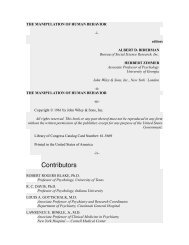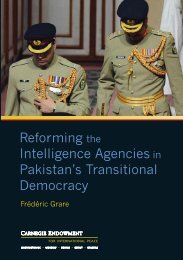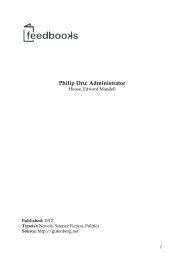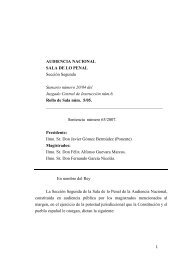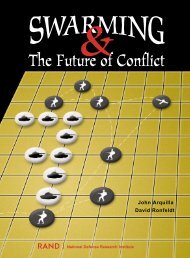The Big Breach - Index of
The Big Breach - Index of
The Big Breach - Index of
Create successful ePaper yourself
Turn your PDF publications into a flip-book with our unique Google optimized e-Paper software.
<strong>The</strong> <strong>Big</strong> <strong>Breach</strong>; From Top Secret to Maximum SecurityCompliments <strong>of</strong> http://www.192.comavoid repeating the same mistake and threw resources at the region,doubling the size <strong>of</strong> its station in Buenos Aires, building a chain <strong>of</strong>listening posts in the Chilean Andes to give early warning <strong>of</strong> Argentineaircraft movements and opening a new one-man station in Uruguay. Soon asteady stream <strong>of</strong> intelligence was coming from these efforts.One piece <strong>of</strong> intelligence was <strong>of</strong> particular interest to the DIS(Defence Intelligence Staff) in Whitehall. <strong>The</strong> Argentines weredeveloping a new and top secret naval mine, made <strong>of</strong> plastic, renderingit difficult to detect using conventional minesweeping techniques. Itcontained electronics which enabled it to distinguish the noisesignatures<strong>of</strong> British and Argentine ships. <strong>The</strong> DIS regarded the newmine as a dangerous threat and wanted details <strong>of</strong> its specification. MI6learned <strong>of</strong> a French weapons technician who was working on the projectin the Rio Gallegos naval base. <strong>The</strong>y successfully recruited him, givinghim the codename FORFEIT.Smuggling the mine out <strong>of</strong> the Rio Gallegos base was not too difficultas FORFEIT had top-level security clearance and was trusted by theArgentine security guards. He loaded one <strong>of</strong> the mines into the boot <strong>of</strong>his car and drove it out <strong>of</strong> the base, claiming that he was taking it toanother naval base in Commodore Rivadavia for sea trials. <strong>The</strong> hard bit<strong>of</strong> the operation was smuggling the mine out <strong>of</strong> Argentina.Options for getting the mine to the UK were constrained by the need toensure that the operation was deniable, so MI6 dared not use asubmarine to sneak into one <strong>of</strong> the bays <strong>of</strong> Argentina's long,unpopulated coastline. MI6 considered recruiting a pilot to fly themine across the River Plate to Uruguay in a light aircraft, and thatwas why Freeman had been disappointed to learn <strong>of</strong> the Luscombe's feeblecapacity. In the end, an MI6 <strong>of</strong>ficer working under cover as a Danishchemical engineer rendezvoused with FORFEIT at a lockup garage inBuenos Aires, transferred the mine to the boot <strong>of</strong> his hire car anddrove it to the Uruguay border. Prior reconnaissance revealed that theborder police rarely searched vehicles but, just in case, thebusinessman had a cover story that the strange barrel-shaped piece <strong>of</strong>plastic in the boot <strong>of</strong> his car was nothing more sinister than a piece<strong>of</strong> chemical engineering equipment. In the event the cover story was notneeded and he drove it without incident to Montevideo. From there itwas clandestinely loaded on to a navy ship which was replenishing aftera Falklands tour, and shipped to the UK.Boarding a Swissair flight back to London in December 1987 at the end<strong>of</strong> an interesting year, I picked up a copy <strong>of</strong> La Nacion, Argentina'sleading newspaper. Down on page five there was an article about a lightaircraft which had crashed while making a night landing at a smallgrass airfield just outside Buenos Aires, killing the pilot. Policewere investigating the wreckage among rumours that the plane was beingused for smuggling. <strong>The</strong> pilot was unnamed but I knew it must beRodolfo.Back in London, without money, I needed a job, preferably one thatsatisfied my sense <strong>of</strong> adventure and desire to work overseas. I wrote toPilchard asking if the <strong>of</strong>fer he had made in 1984 was still open. Hedidn't reply directly, but a couple <strong>of</strong> weeks later a letter arrived onFCO (Foreign and Commonwealth Office) crested paper signed by a Mr M.A.Halliday inviting me to an interview at 3 Carlton Gardens, London SW1.page- 13 - To purchase the original limited edition hardback version <strong>of</strong> this bookplease call 08000 192 192 or go to http://www.192.com



